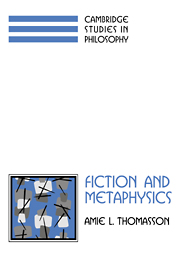Book contents
- Frontmatter
- Contents
- Acknowledgments
- Introduction: From Fiction Into Metaphysics
- Part One The Artifactual Theory of Fiction
- Part Two Ontological decisions
- Foreword
- 6 Fiction and experience
- 7 Fiction and language
- 8 Ontology and categorization
- 9 Perils of false parsimony
- 10 Ontology for a varied world
- Notes
- Bibliography
- Index
6 - Fiction and experience
Published online by Cambridge University Press: 23 September 2009
- Frontmatter
- Contents
- Acknowledgments
- Introduction: From Fiction Into Metaphysics
- Part One The Artifactual Theory of Fiction
- Part Two Ontological decisions
- Foreword
- 6 Fiction and experience
- 7 Fiction and language
- 8 Ontology and categorization
- 9 Perils of false parsimony
- 10 Ontology for a varied world
- Notes
- Bibliography
- Index
Summary
The task of a theory of intentionality is to offer an analysis of the directedness of our thoughts and experiences towards those objects in the world that they are about. Theories of intentionality, like those of language, have often been directed by a desire to avoid postulating fictional entities and have sought alternatives to Meinongian theories of intentionality just as Russell sought an alternative to a Meinongian theory of reference. The main line of devising a theory of intentionality that avoids fictional objects is the content approach, which was first formulated in modern terms by Husserl and is defended in a number of contemporary theories of intentionality, including those of Searle, Smith, and Mclntyre.
According to content theories, ordinary intentional relations to objects of our veridical perceptions can be analyzed into three basic parts: The conscious act, the object, and the content. The conscious act is the particular perceiving, thinking, wishing, or so forth that occurs at a particular place and time. The object of the intentional relation is the thing the perception, thought, or so forth is of or about, normally just an ordinary physical individual or state of affairs that is chanced upon by the intentional act. The content of an act plays a role analogous to Fregean senses; it is what picks out, or prescribes, the object of the intentional act; it is dependent upon the subject's conception of, and angle of perception of, the object, but it is normally not something of which the subject is explicitly aware during the intentional experience. In particular, the content is not the object of the intentional act.
- Type
- Chapter
- Information
- Fiction and Metaphysics , pp. 76 - 92Publisher: Cambridge University PressPrint publication year: 1998



